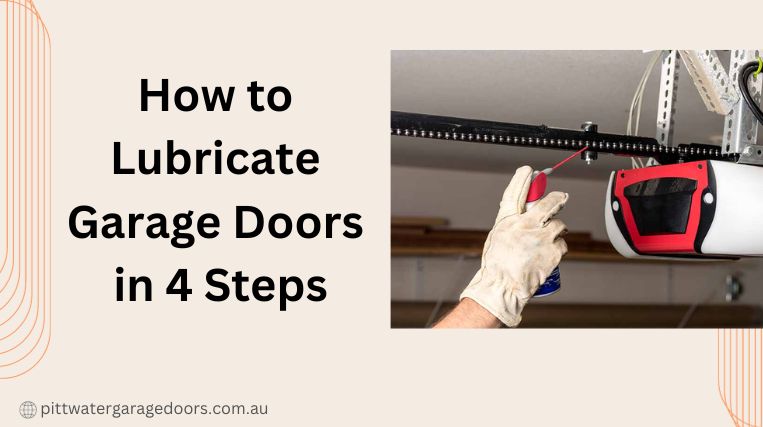Lubrication of a garage door involves applying lubricant to its moving parts to minimise friction, prevent rust, and ensure smooth operation. This process usually targets hinges, rollers, tracks, and springs.
Proper lubrication can reduce noise, facilitate seamless movement, and prolong the door’s lifespan. It’s typically done using silicone or lithium-based products.
Regular garage door maintenance is crucial to ensure the safety, functionality, and longevity of this essential household feature.
Neglecting maintenance can lead to safety hazards, inconvenient breakdowns, and costly repairs. It’s a preventive measure that keeps your garage door working smoothly and efficiently.
In areas like the northern beaches of Sydney, with high humidity, saltwater exposure, or frequent rainfall, the components of a garage door are more prone to corrosion and rust.
These weather conditions can accelerate wear and tear on the moving parts, such as hinges, rollers, and tracks. As a result, more frequent lubrication may be required to protect the door and ensure smooth operation.
The lubrication of a garage door starts with an inspection of the door to lubrication of the tracks and springs.
Table of Contents
How to Lubricate the Garage Door
The steps on how to lubricate the garage door are mentioned below.
Step 1: Inspect the door
Before lubricating, visually inspect the garage door and its components for signs of wear, damage, or rust. Identifying any issues in advance will enable you to address them during the lubrication process, ensuring the door functions optimally.
Step 2: Clean the components
Ensure that the hinges, rollers, tracks, and springs are free of dirt, dust, and debris. A clean surface allows the lubricant to adhere effectively, facilitating smoother door movement.
Step 3: Apply lubricant to hinges and rollers
Carefully apply a small amount of appropriate lubricant to the hinges and rollers, covering all moving parts evenly. Operating the door manually can help distribute the lubricant, enhancing its effectiveness.
Step 3: Lubricate the tracks
Apply a thin, uniform layer of lubricant to both sides of the tracks, ensuring complete coverage from top to bottom. Manually move the door up and down a few times to distribute the lubricant along the entire track evenly.
Step 4: Lubricate the springs
Apply a modest amount of lubricant to the garage door springs, ensuring even coverage. Please exercise caution when working with the springs, as they are under tension and should be treated carefully to prevent accidents or damage.
Signs Garage Door Needs Lubrication
Signs that indicate a garage door needs lubrication are mentioned below.
- Squeaking or Grinding Noises: If your garage door produces squeaking, grinding, or other unusual noises during operation, it indicates that its moving parts require lubrication to reduce friction.
- Jerky or Uneven Movement: When your garage door moves unevenly or in a jerky manner, it can indicate insufficient lubrication on its hinges, rollers, or tracks.
- Stiff Operation: If the door is difficult to open or close, it may be due to components that have become dry or corroded, necessitating lubrication to restore smooth operation.
- Rust or Corrosion: The presence of rust or corrosion on the door’s metal components indicates that lubrication is needed to protect against further deterioration.
- Slowed Opening or Closing: If your garage door operates more slowly than usual, lubricating the moving parts can help restore its regular speed and efficiency.
Choosing the Right Lubricant
Selecting the proper lubricant for your garage door is a crucial step in maintenance. Garage doors often benefit from different types of lubricants, including silicone-based, lithium-based, and white lithium grease.
The choice should be influenced by factors like the local climate, the door’s material, and any manufacturer recommendations.
To ensure safe application, don safety glasses and gloves to protect against potential contact or splashes from the lubricant.
In the Northern Beaches of Sydney, as in many coastal areas, it’s advisable to use a high-quality silicone-based or marine-grade lubricant for garage doors.
These lubricants are better equipped to resist the effects of high humidity, saltwater exposure, and coastal climate conditions, which can accelerate corrosion and wear on garage door components.
They offer improved protection against rust and ensure the smooth and efficient operation of the garage door in this specific environment.
Takeaway
Regular garage door maintenance, including proper lubrication, is essential to ensure the safety, functionality, and longevity of this indispensable household feature.
Neglecting maintenance can lead to safety hazards, inconvenient breakdowns, and costly repairs, making preventive measures like lubrication crucial.
While DIY maintenance is effective, there may come a point where professional expertise is needed, especially if your garage door shows signs of significant wear or damage.
In such cases, it’s advisable to seek the assistance of a professional garage door service.
Our garage door servicing is designed to do just that. With regular inspections, maintenance, and professional lubrication, we ensure that your garage door continues to operate optimally, ultimately extending its lifespan.
This not only saves you time and money but also provides peace of mind, knowing that your garage door is in the best possible condition, ready to serve you reliably day in and day out.
Don’t wait for problems to arise – invest in regular garage door servicing to keep your garage door in top shape and prolong its lifespan.
Call us at (02) 9971 1111 to get a FREE quote.


